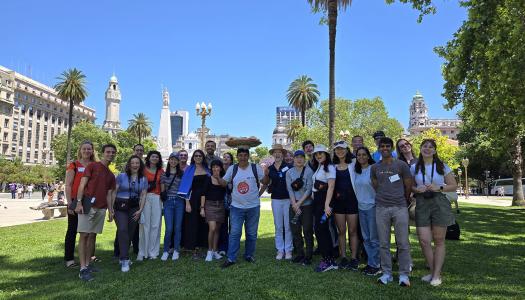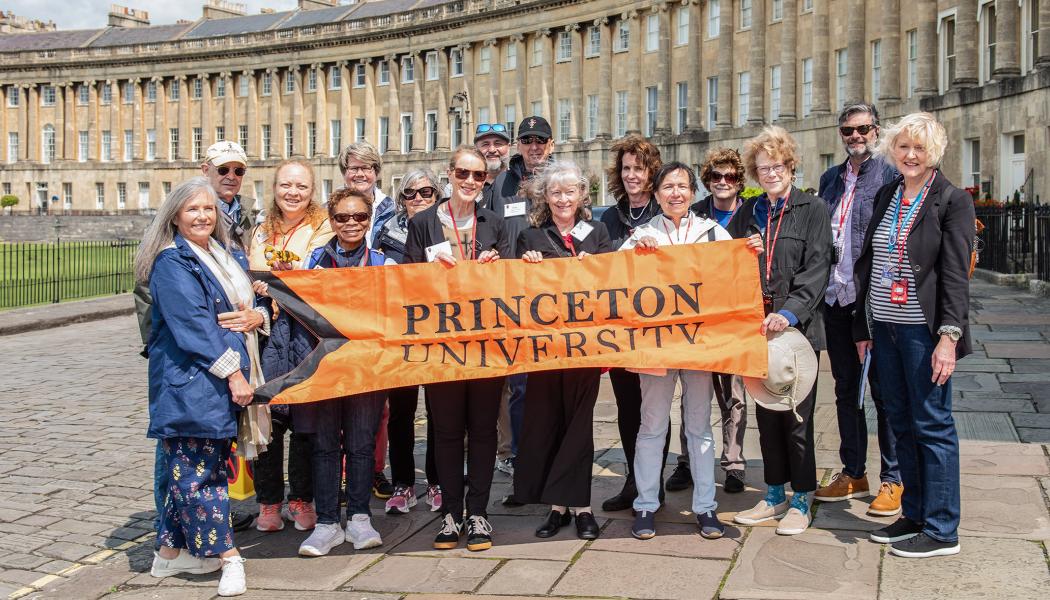
Travelers at No. 1 Royal Crescent
“My idea of good company, Mr. Elliot, is the company of clever, well-informed people, who have a great deal of conversation; that is what I call good company.”
— from “Persuasion,” by Jane Austen
It was a destination birthday party, opening with an amiable, well-lit scene in the Castle Suite conference room in a Winchester hotel. There was no cake with candles, and while the celebrant was 250 years old, and could not attend in person, her spirit was anticipated by all in the room.
The two dozen guests sitting in the red-upholstered conference room chairs were all “clever, well-informed people,” as defined by Anne Elliot, the heroine of “Persuasion.” These Princetonians and friends were embarking on a distinctive Princeton Journeys experience of Jane Austen’s England that would take them across the countryside and to a new understanding of the author’s life and work.
Kicking off the Princeton Journey in Jane Austen’s 250th anniversary year was study leader Claudia Johnson *81, the Murray Professor of English Literature at Princeton University and a renowned Austen scholar, with an illuminating lecture titled “Why Jane Austen?”
Johnson said that Austen elevates “humdrum manners” to world significance. “Inconspicuous, humdrum but mighty, she dignified the lives of ordinary people. And she did this with unparalleled artistry and wit.”
The Great House and the Cottage
“I am excessively fond of a cottage; there is always so much comfort, so much elegance about them. And I protest, if I had any money to spare, I should buy a little land and build one myself, within a short distance of London, where I might drive myself down at any time, and collect a few friends about me and be happy.”
― from “Sense and Sensibility”
There was a darkening, gothic sky looming over Chawton House, an Elizabethan manor that once belonged to Austen’s brother, Edward Austen-Knight, as we disembarked from the tour bus and approached the “great house” and grounds.
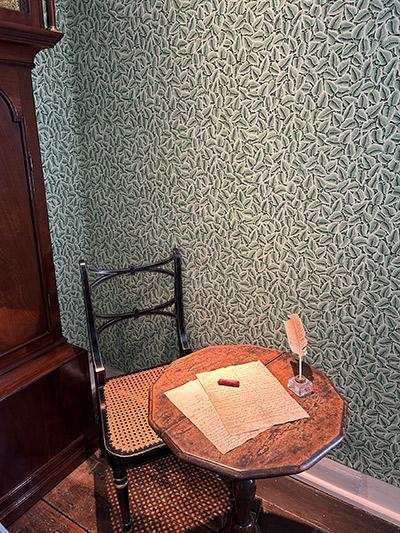
Outside, pink roses rambled up over the manor’s brick walls, and poppies danced delicately, catching the breeze as an impending cloudburst gathered overhead. Inside, the group enjoyed a personal tour from the property’s curator, who shared the history of the estate as well as its paintings and objects, including an exhibit of books by Austen and her contemporaries.
“Truly the most important space for me was Chawton Cottage, followed by Chawton House and the church,” said traveler Mary Blair W67. “That first day brought her life, her family and her evolution as a writer alive for me.”
Lunch was in the village of Chawton, which ended in glory with bowls of rhubarb crumble drowning in yellow English custard. Well-fed, we crossed the street to the Jane Austen’s House museum, a charming cottage where Austen spent the last years of her life and wrote six novels. In the cozy space, we could imagine her sitting at her wooden desk by the window with paper and quill pen, conjuring Barton Cottage, where Elinor and Marianne Dashwood live with their mother in “Sense and Sensibility.”
“The most powerful image from our extraordinary tour is the tiny wooden tabletop, no bigger than a serving tray, where Jane Austen wrote her far-reaching novels,” said Susan Humphreys *79, P02.
Bath and Beyond
“She hoped to be more fortunate the next day; and when her wishes for fine weather were answered by seeing a beautiful morning, she hardly felt a doubt of it; for a fine Sunday in Bath empties every house of its inhabitants, and all the world appears on such an occasion to walk about and tell their acquaintance what a charming day it is.”
― from “Northanger Abbey”
Bath was home to Austen from 1801 to 1806, and it would be our home base as well for the next few days of our journey. We greeted Day 3 with a post-breakfast lecture from Professor Johnson, who began with “Jane Austen is Bath, Bath is Jane Austen. The gardens, circuses, trellises all scream Jane Austen.”
Johnson provided historic context for Bath and its presence in Austen’s novels, starting with its Roman origins through its popularity as a fashionable spa city in the 1800s. Scenes from Bath appear in the works of literary greats, from Mary Shelley to Charles Dickens. But despite the prominence of the city in her novels, Austen really didn’t move to the center stage, Johnson said, until British soldier R.A.L. Smith published “Bath” in 1944. The penultimate chapter of his book was devoted to her. While much of the city was under rubble from World War II bombings as he wrote his book, Smith “believed the damage would not last because the city is eternal,” she said. “His Bath is an Austenean woman of grace and poise who cannot be violated,” Johnson said.
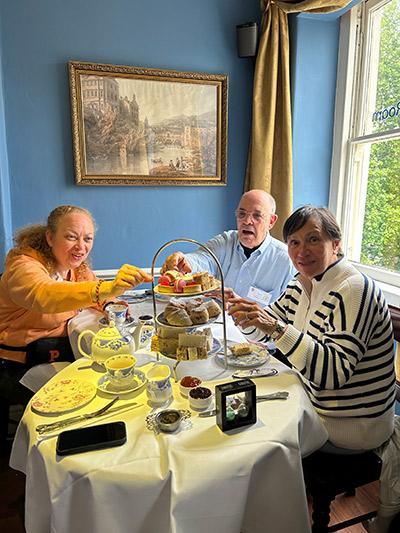
Johnson also shared a map of Bath during Austen’s time, and how the class hierarchy portrayed in novels like “Northanger Abbey” and “Persuasion” corresponded with specific geographical locations. With that map in mind, we went on a walking tour of Bath, including Trim Street, where Austen lived at the end of her time in Bath in a neighborhood that would have been frequented by beggars and thieves.
At the Jane Austen Centre, our ultimate destination for the day, we started our visit with a dramatic portrayal of the Austen character Anne Eliott. Mr. Darcy of “Pride and Prejudice” was our spirit animal throughout; the group enjoyed exploring the exhibits of the Centre, including donning Regency-era costumes to pose with a mannequin dressed as Mr. Darcy, and enjoying a high tea with towers of dainty sandwiches, macarons and scones and porcelain cups of Earl Grey tea … all watched over by a brooding portrait of Colin Firth as Mr. Darcy.
Cinematic Spaces
“The rooms were lofty and handsome, and their furniture suitable to the fortune of its proprietor; but Elizabeth saw, with admiration of his taste, that it was neither gaudy nor uselessly fine; with less of splendour, and more real elegance, than the furniture of Rosings.”
― from “Pride and Prejudice”
Cinematic grandeur was the theme of the next two days as we visited palatial estates and soaring cathedrals, passing Stonehenge on our way to Wilton House, the seat of the Earl of Pembroke for more than four and a half centuries.
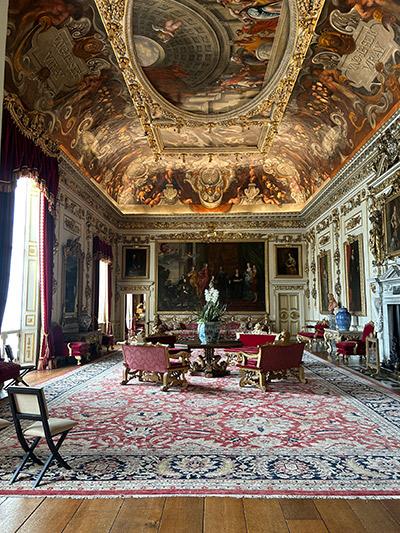
Wilton House is a grand example of Palladian architecture and served as a filming location for the 2005 movie adaptation of “Pride and Prejudice.” The tour featured room after room of priceless art, statuary and furnishings. Highlights included a monumental statue of Shakespeare, gothic cloisters lined with Greek and Roman statuary and portraits by Holbein and Rembrandt. The “Double Cube room” is filled with paintings by Van Dyck and boasts a Bacchanalian scene painted on the ceiling. During World War II, Churchill and Eisenhower used the space as the top-secret operations room for D-Day.
The group visited two other cinematic locations: Bowood House and Lacock Abbey. Bowood House is the family home of the Marquis and Marchioness of Lansdowne and was a filming location for the 2007 TV film, “Northanger Abbey.” Espaliered trees grace the front of the home, and two massive stag statues overlook the Italian-inspired terrace garden outside, which features climbing roses, formal box hedges and herbaceous borders.
Lacock Abbey was once a medieval nunnery and became the family home of William Henry Fox Talbot, the inventor of the first photographic negative in 1835. Fast-forward the film to this century, and the Abbey has been used as a location for the Harry Potter films, “Pride and Prejudice” and “Downton Abbey.”
The Sea and Seeing
“There was too much wind to make the high part of the new Cobb pleasant for the ladies, and they agreed to get down the steps, and all were contented to pass quietly and carefully down the steep flight, excepting Louisa; she must be jumped down them by Captain Wentworth.”
― from “Persuasion”
Like Austen characters, we felt the curative effects of sea air at Lyme Regis, a seaside town in Dorset and one of the most famous fossil locations in the world. We began our visit with a visit to the Lyme Regis Museum, which traveler Anna Finn ’02 called “a wonderful hodge-podge.” There, we saw fossils found in the area, items recovered from the seashore by mud larks, and exhibits about pioneering paleontologist Mary Anning, children’s author Beatrix Potter and the Austen family, among other ephemera and treasures.
Following a signature lunch of fish and chips and a berry-infused “summer pudding,” we explored a vast seaside beach of stones, each promising to yield ammonites and coprolites if only we had fossil hammers in hand. Victoria Barwell, our Blue Guide-certified guide for the entire trip, led the group along the beach to the Cobb, where she pointed out the steps where Louisa nearly meets her demise in “Persuasion.”
“The ferocious Cobb breakwater in Lyme Regis was a much scarier place for a young lady to fling herself than I imagined when reading ’Persuasion,‘” said Humphreys.

From the seaside to three awe-inspiring cathedrals, this Journey was balm for the Austen aficionado’s soul. At Salisbury Cathedral, which has the tallest spire in Britain, we saw the world’s oldest working church clock and one of the four original copies of the Magna Carta. At Wells Cathedral, we saw the world’s second-oldest church clock, breathtaking stained-glass windows and a peaceful chapter house where priests would conduct business. Outside Wells Cathedral, we took turns peering through a stone wall to glimpse a freshwater spring, a magical opening between worlds.
Twilight
“The benevolence of her heart, the sweetness of her temper, and the extraordinary endowments of her mind obtained the regard of all who knew her, and the warmest love of her intimate connections.”
― Excerpt from the inscription on the tomb of Jane Austen
Our last stop was Winchester, where we saw the home where Austen spent the last six weeks of her life and where she died at 41, her sister Cassandra attending faithfully by her bedside. We also visited Winchester Cathedral, which is Austen’s final resting place.
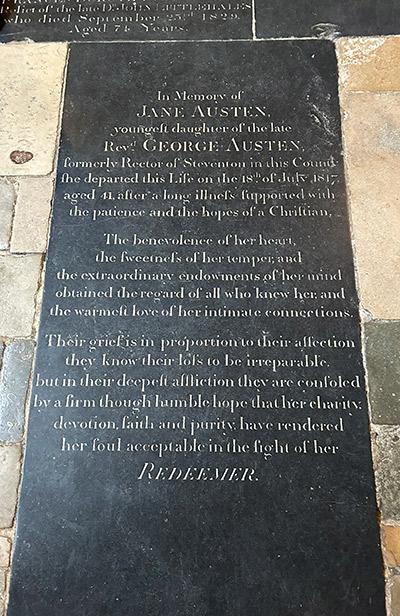
“Seeing three astonishing cathedrals was a highlight of the trip for me,” said traveler Sally Drayer. “I was embraced and lifted up by all of them, but Winchester Cathedral was the most moving for many reasons. Austen is buried there, but what an ordeal it was for her to even find her final resting place.”
“One really wonders what else she would have done if she had more time,” Finn added.
On a group messaging app, we would continue to muse on this long after we all returned from our Austen idyll, with travelers posting insights from their reading, recommendations about articles and exhibits, and observations about the journey. “I would now like to go back and read all her novels,” said traveler Rick Hankins.
But, dear reader, let us not end with the afterword, but with one more indelible image. On the final evening of our journey spent contemplating both the soaring achievements and the waning hours of the great author, we headed out on a farewell river boat ride on the Thames, raising our glasses to one another and to Jane Austen as twilight fell.

